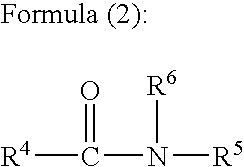Cellulose acylate film, optical compensation film, method of producing cellulose acylate film, polarizing plate and liquid crystal display
a technology of cellulose acylate and cellulose acylate, which is applied in the direction of instruments, transportation and packaging, chemistry apparatuses and processes, etc., can solve the problems of lowering the processability of polarizing plates, film retardation increasing, and optical performance exceeding the desired scope, and achieve excellent polarizing plate processability and small environment dependence. effect of optical performan
- Summary
- Abstract
- Description
- Claims
- Application Information
AI Technical Summary
Benefits of technology
Problems solved by technology
Method used
Image
Examples
example 1
[0498]≦Preparation of Cellulose Acylate Solution>
[0499] After a composition disclosed in Tables 1 and 1-2 was put in a pressure-resistant mixing tank and agitated for 1 hour, it was agitated for 6 hours while it was heated to 80° C. to dissolve components, to prepare cellulose acylate solutions T-1 to T-12, T-21 to T-23, and T-31 to T-33. In addition, in a parenthesis of a column of the degree of substitution in Tables 1 and 1-2, a group name of a substituted acyl group is shown.
[0500]≦R of Additives to be Used>
[0501] Furthermore, an R value of a used main additive was obtained using the method disclosed in the specification, and the results are shown in Tables 2 and 2-2.
TABLE 1Composition of Cellulose Acylate Solution (unit: parts by weight)CelluloseCellulose acylateacylateMethylene1-Degree ofAmount ofsolutionchlorideMethanolButanolsubstitutionadditionAdditiveT-130054112.86 (acetyl)100TPP / DBP7.8 / 3.9T-230054112.86 (acetyl)100Comparative8.0compound 1T-330054112.86 (acetyl)100Compa...
example 2
[0536] 17% by weight of the cyclohexanone solution of polyimide (weight average molecular weight (Mw) was 60,000), which was synthesized from 2,2′-bis(3,4-dicarboxyphenyl)hexafluoropropane and 2,2′-bis(trifluoromethyl)-4,4′-diaminobiphenyl, was applied on the cellulose acylate film sample 001 produced above, and dried at 95° C. for 12 minutes to obtain a transparent film in which a residual solvent amount was 6% by weight, a thickness was 6 μm, |Rth(630)| was 233 nm, and Re(630) was 0 nm. While it was layered on the film sample 001, unidirectional drawing treatment was horizontally conducted by 18% so that a glass transition temperature (Tg) of the polymer film was −5° C. to obtain an optical compensation film 001E having an optically anisotropic layer in which Re(630) was 55 nm and |Rth(630)| was 238 nm.
[0537] (Production of Optical Compensation Films of Samples 002 to 006, 101 to 112, 201, 121 to 123 and 131 to 133)
[0538] In addition, for the cellulose acylate film samples 002 t...
example 3
[0559] (Mounting Evaluation for IPS Type Liquid Crystal Display)
[0560] Mounting evaluation for a liquid crystal display was conducted using the cellulose acylate film sample produced in Example 1 to confirm whether optical performance thereof was desired. Furthermore, an IPS-type liquid crystal cell was used in the present Example, and VA and OCB type liquid crystal cells were used in other examples. The purpose of the polarizing plate or the optical compensation film using the cellulose acylate film of the invention is not limited to an operation mode of the liquid crystal display.
[0561] An optical compensation film in which an ARTON film (manufactured by JSR Corp.) was unidirectionally drawn was bonded to a polarizing plate sample 001, which was produced in the same manner as in Example 2, except that the film of the invention was used before the optically anisotropic layer was layered using the cellulose acylate film sample 001 produced in Example 1, to provide an optical compe...
PUM
 Login to View More
Login to View More Abstract
Description
Claims
Application Information
 Login to View More
Login to View More - R&D
- Intellectual Property
- Life Sciences
- Materials
- Tech Scout
- Unparalleled Data Quality
- Higher Quality Content
- 60% Fewer Hallucinations
Browse by: Latest US Patents, China's latest patents, Technical Efficacy Thesaurus, Application Domain, Technology Topic, Popular Technical Reports.
© 2025 PatSnap. All rights reserved.Legal|Privacy policy|Modern Slavery Act Transparency Statement|Sitemap|About US| Contact US: help@patsnap.com



